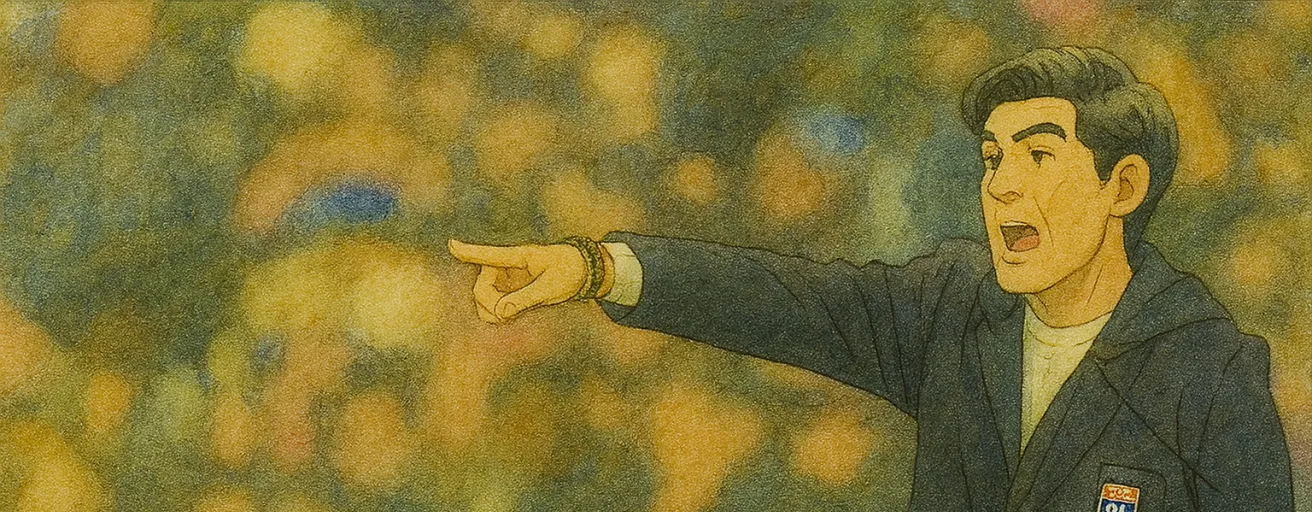
Paulo Fonseca
Fonseca, the architect of possession-driven, high pressing 4–2–3–1, is out to outplay OM—his tactical clarity is a direct challenge to our Champions League hopes.
Paulo Fonseca’s recent installation as head coach at Olympique Lyonnais arrives with a managerial résumé that demands close attention. Most relevant to OM’s interests is his proven competency in extracting competitive consistency from under-resourced squads and his appetite for tactical sophistication at Shakhtar Donetsk, Roma, Lille, and, briefly, Milan.
Of particular note are his three consecutive doubles in Ukraine and his rehabilitation of Lille’s fortunes — albeit never at the absolute summit of Ligue 1, where OM must aim. Now at the helm of Lyon as of January 2025, Fonseca embodies both a direct threat and a benchmark, given OL’s ambitions to disrupt the established Ligue 1 hierarchy.
Tactical Approach
- Fonseca’s football is rooted in a progressive, possession-based 4–2–3–1, characterized by positional fluidity, high pressing, and quick transitions.
- He often employs a second striker or advanced playmaker to overload dangerous zones, drawing inspiration from Sarri and Guardiola’s philosophies but adapting them with a pragmatic eye.
- His methods prioritize controlling territory, with forcing mistakes in the opponent’s half a clear theme.
- Adaptability is shown by shifting into a 3–4–3 or altering defensive structures when confronting top-tier competition.
Management Style
- Brings structure and psychological nuance to the sideline.
- Uses scenario-based training and video analytics, highlighting a detail-oriented management approach.
- Instills team unity and individual accountability, evident during his nine-month Ligue 1 ban preparation for OL.
Performance and Strategy
Importantly, Fonseca’s methods have yielded consistent, if not sparkling, improvements. His Lille sides showcased disciplined organization and offensive layering, challenging opponents like OM to solve pressing traps and complex build-ups. However, teams demonstrate defensive fragility under sustained pressure, seen during European semifinals with Roma and his exit from Milan. Strategically, OM must treat Fonseca’s Lyon with circumspection reserved for legitimate rivals—neither invincible nor frequently permissive.
Fonseca’s adeptness at galvanizing squads means match preparations against OL demand tactical precision and psychological alertness. He leverages analytics and in-match adjustments to disrupt rhythm and exploit OM’s transition vulnerabilities. Recent matches, such as his team’s disciplined win over Lille or the high-pressure victory against Marseille on debut, highlight OL under Fonseca as structurally sound, tempo controllers, yet building resiliency under duress.
Competitive Threat and Learning
From a competitive standpoint, Fonseca’s Lyon poses a present threat — less in raw talent, more in strategic consistency and improved defensive organization. His approach, while meticulous, lacks the creative unpredictability or imposing presence OM supporters expect on grand occasions. However, his blueprint, with commitment to analytics and scenario-based conditioning, is worth studying for potential gains by OM.
The Fonseca effect at Lyon is a catalyst for renewed rivalry, not insurmountable opposition. His tactical clarity necessitates a strategic response, but the ceiling for his current squad is below championship ambitions. OM faces a dual learning opportunity: stress-testing tactical frameworks against pressing traps and considering how his analytical rigor could inform preparations. While Lyon may grow tougher, OM must assert superiority through intelligent, adaptable implementation across club levels.